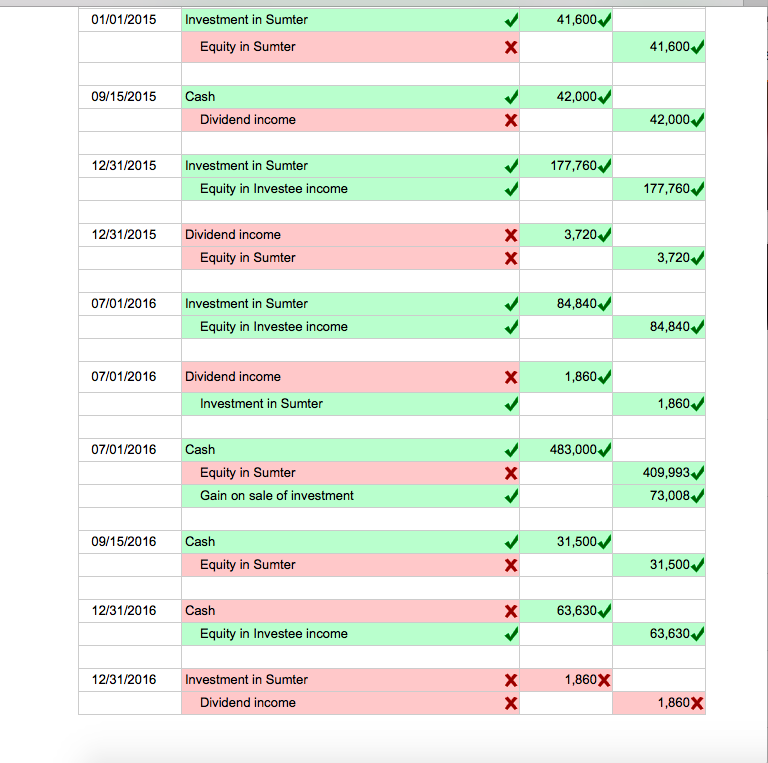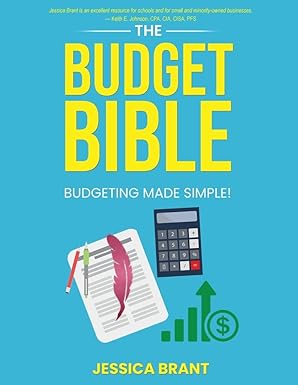Question
Please answer the parts i got wrong. On January 1, 2013, Plano Company acquired 8 percent (16,800 shares) of the outstanding voting shares of the
Please answer the parts i got wrong.
 On January 1, 2013, Plano Company acquired 8 percent (16,800 shares) of the outstanding voting shares of the Sumter Company for $235,200, an amount equal to Sumters underlying book and fair value. Sumter declares and pays a cash dividend to its stockholders each year of $105,000 on September 15. Sumter reported net income of $326,000 in 2013, $404,000 in 2014, $444,400 in 2015, and $424,200 in 2016. Each income figure can be assumed to have been earned evenly throughout its respective year. In addition, the fair value of these 16,800 shares was indeterminate, and therefore the investment account remained at cost. On January 1, 2015, Plano purchased an additional 32 percent (67,200 shares) of Sumter for $1,148,150 in cash and began to use the equity method. This price represented a $55,800 payment in excess of the book value of Sumters underlying net assets. Plano was willing to make this extra payment because of a recently developed patent held by Sumter with a 15-year remaining life. All other assets were considered appropriately valued on Sumters books. On July 1, 2016, Plano sold 10 percent (21,000 shares) of Sumters outstanding shares for $483,000 in cash. Although it sold this interest, Plano maintained the ability to significantly influence Sumters decision-making process. Assume that Plano uses a weighted average costing system. Prepare the journal entries for Plano for the years of 2013 through 2016.
On January 1, 2013, Plano Company acquired 8 percent (16,800 shares) of the outstanding voting shares of the Sumter Company for $235,200, an amount equal to Sumters underlying book and fair value. Sumter declares and pays a cash dividend to its stockholders each year of $105,000 on September 15. Sumter reported net income of $326,000 in 2013, $404,000 in 2014, $444,400 in 2015, and $424,200 in 2016. Each income figure can be assumed to have been earned evenly throughout its respective year. In addition, the fair value of these 16,800 shares was indeterminate, and therefore the investment account remained at cost. On January 1, 2015, Plano purchased an additional 32 percent (67,200 shares) of Sumter for $1,148,150 in cash and began to use the equity method. This price represented a $55,800 payment in excess of the book value of Sumters underlying net assets. Plano was willing to make this extra payment because of a recently developed patent held by Sumter with a 15-year remaining life. All other assets were considered appropriately valued on Sumters books. On July 1, 2016, Plano sold 10 percent (21,000 shares) of Sumters outstanding shares for $483,000 in cash. Although it sold this interest, Plano maintained the ability to significantly influence Sumters decision-making process. Assume that Plano uses a weighted average costing system. Prepare the journal entries for Plano for the years of 2013 through 2016.
1. Record the cost of 16,800 shares of Sumter Company.
2.Record the annual dividends declared and received from Sumter Company. Because declaration and payment are on same day, a dividend receivable account is unnecessary.
3.Record the annual dividends declared and received from Sumter Company.
4.Record the cost of 67,200 additional shares of Sumter Company.
5.Record the entry to recoginze the retrospective effect of change to equity method.
6.Record the annual dividend declared and received from Sumter.
7.Record the accrued 2015 income based on 40% ownership of Sumter.
8.Record the amortization of $55,800 patent over 15 years.
9.Record the accrued year income of 40% ownership.
10.Record the year amortization of patent to establish correct book value for investment as of 7/1/16.
11.Record the 21,000 shares of Sumter Company sold.
12.Record the annual dividend declared and received.
13. Record the year income based on remaining 30% ownership. Record the year of patent amortization.
01/01/2015 Investment in Sumter Equity in Sumter 09/15/2015 Cash Dividend income 12/31/2015 Investment in Sumter Equity in Investee income 12/31/2015 Dividend income Equity in Sumter 07/01/2016 nvestment in Sumter Equity in Investee income 07/01/2016 Dividend income Investment in Sumter 07/01/2016 Cash Equity in Sumter Gain on sale of investment 09/15/2016 Cash Equity in Sumter 12/31/2016 Cash Equity in Investee income 12/31/2016 nvestment in Sumter Dividend income x x x x 41,600 42,000 177,760 3,720 84,840 1,860 483,000 31,500 63,630 1,860X 41,600 42,000V 177,760 3,720 84,840 1,860 409,993 73,008 31,500 63,630 1,860XStep by Step Solution
There are 3 Steps involved in it
Step: 1

Get Instant Access to Expert-Tailored Solutions
See step-by-step solutions with expert insights and AI powered tools for academic success
Step: 2

Step: 3

Ace Your Homework with AI
Get the answers you need in no time with our AI-driven, step-by-step assistance
Get Started


